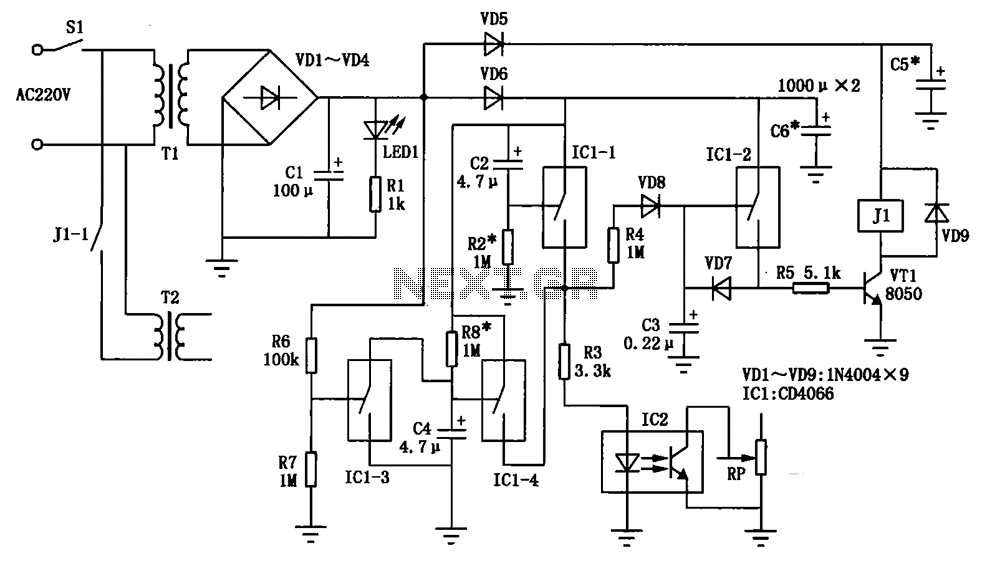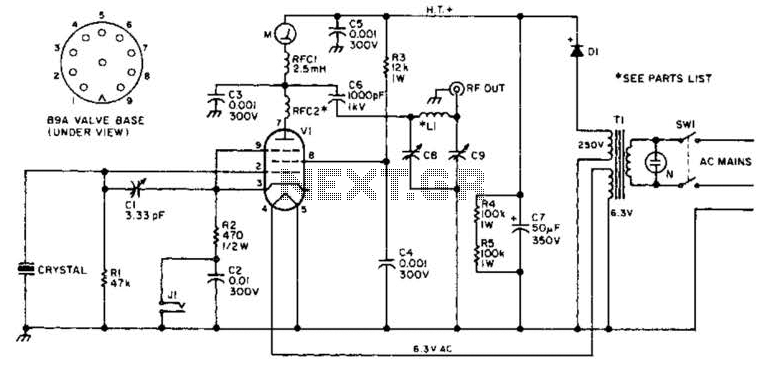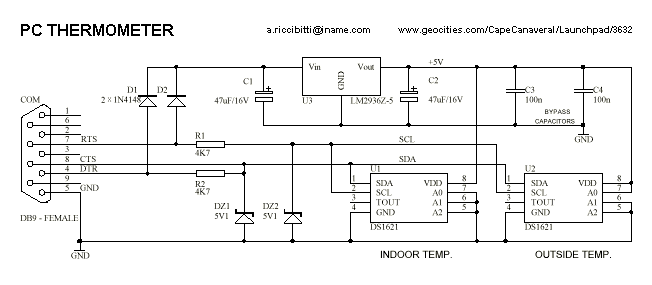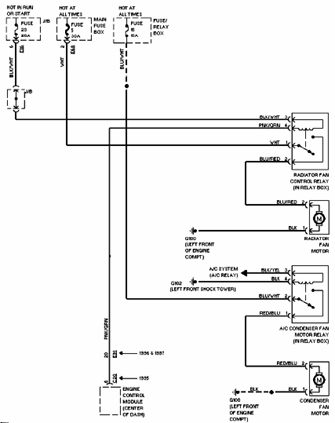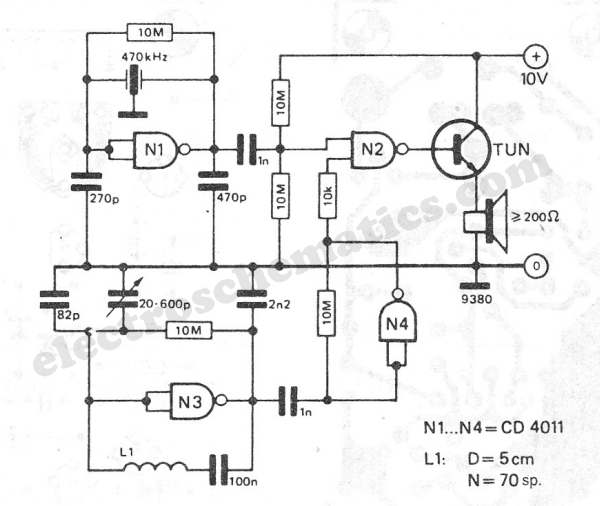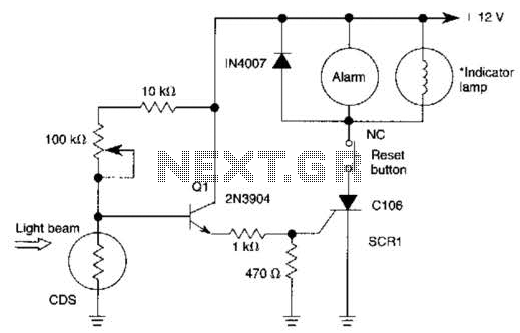
JS20 single-junction transistor time relay circuit
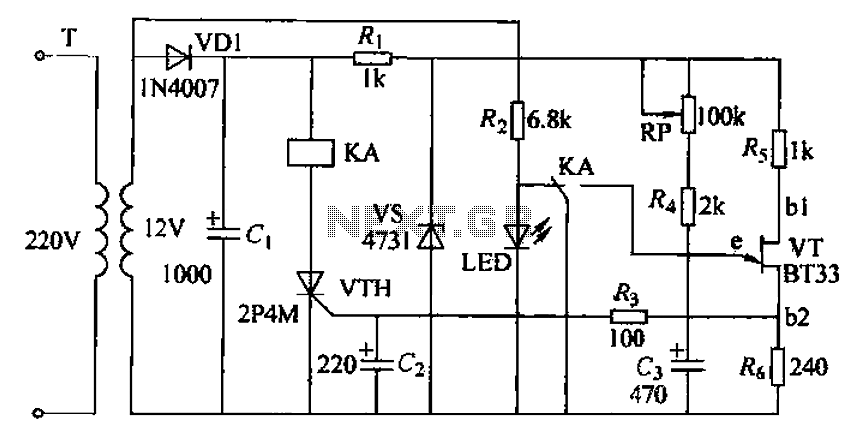
The circuit consists of a delay loop, discriminators, output circuits, power supply, and indicator lights, divided into five parts. The power regulation is achieved through a resistor (R), while the power regulator is constructed using a voltage source. In the delay section, the output circuit includes a thyristor (VTH) and a relay (KA), powered directly by a half-wave rectifier circuit. The operation of the circuit is as follows: Upon powering on, diode (VD1) rectifies the input, and filter capacitor (C1) charges through resistors (R1) and (VS) regulator, with the resistor (RP1) and capacitor (C4) contributing to the charging process. The voltage across capacitor (C4) increases exponentially. Once this voltage exceeds the peak voltage of the single-junction transistor (VT), the transistor turns on, allowing current to flow through (G) and causing capacitor (C3) to discharge rapidly. This generates a trigger pulse for the thyristor (VTH), activating relay (KA) and closing its contacts, which short-circuits capacitor (C3) for a quick discharge. The voltage across the single-junction transistor (VT) decreases rapidly until it reaches the valley point voltage (Vr), at which point the transistor turns off, and an LED indicator lights up. When the power is turned off, relay (KA) releases, restoring the circuit to its original state and preparing for the next operation. The delay time can be adjusted by varying the resistance of (RP).
The circuit design employs a half-wave rectifier configuration, which is efficient for converting AC to DC power. The diode (VD1) plays a critical role in allowing current to pass in one direction, thus charging the filter capacitor (C1) and providing a stable DC voltage to the subsequent components. The use of a single-junction transistor (VT) as a switch is advantageous due to its low drive requirements and fast response time, which is essential for applications requiring quick on-off control.
The charging behavior of capacitor (C4) is exponential, governed by the RC time constant defined by the resistor (RP1) and the capacitor's capacitance. This time constant dictates the delay before the transistor (VT) activates. The relay (KA) is used to control larger loads, providing isolation between the control circuit and the output circuit. The LED indicator serves as a visual cue, confirming the operational status of the circuit.
The rapid discharge of capacitor (C3) through the relay contacts ensures quick response times, which is crucial for applications where timing is critical. The design allows for fine-tuning of the delay interval, making it versatile for various applications requiring precise timing control. Overall, this circuit exemplifies a reliable solution for delay-based operations in electronic systems. Circuit by the delay loop, discriminators, output circuits, power and lights of five parts. Part of the power regulator by resistance R, and the regulator vs constituted power as part of the delay, the output circuit of the thyristor VTH and relay KA by a half-wave rectifier circuit powered directly. The circuit works as follows: When the power is turned on, the diode VD1 rectifier, filter capacitor cl and after RJ and VS regulator, by RP1, R4 G capacitor is charged.
Capacitor voltage G gradually increased exponentially, when this power when pressure is greater than the single-junction transistor VT peak voltage, single- junction transistor is turned on, G pole and wind through the VT eb1 discharge in wind output pulse voltage trigger Phan brake pipe VTH conduction pull the relay KA, KAs contacts while the short circuit C3, so that the rapid discharge, single -junction transistor voltage between ebl rapid decline, when descending to Vr. Valley point voltage, Vr is closed. At the same time LED indicator lights. When the power is turned off, the relay KA release circuit to restore the original state, waiting for the next action.
By adjusting the RP. You can adjust the delay time.
The circuit design employs a half-wave rectifier configuration, which is efficient for converting AC to DC power. The diode (VD1) plays a critical role in allowing current to pass in one direction, thus charging the filter capacitor (C1) and providing a stable DC voltage to the subsequent components. The use of a single-junction transistor (VT) as a switch is advantageous due to its low drive requirements and fast response time, which is essential for applications requiring quick on-off control.
The charging behavior of capacitor (C4) is exponential, governed by the RC time constant defined by the resistor (RP1) and the capacitor's capacitance. This time constant dictates the delay before the transistor (VT) activates. The relay (KA) is used to control larger loads, providing isolation between the control circuit and the output circuit. The LED indicator serves as a visual cue, confirming the operational status of the circuit.
The rapid discharge of capacitor (C3) through the relay contacts ensures quick response times, which is crucial for applications where timing is critical. The design allows for fine-tuning of the delay interval, making it versatile for various applications requiring precise timing control. Overall, this circuit exemplifies a reliable solution for delay-based operations in electronic systems. Circuit by the delay loop, discriminators, output circuits, power and lights of five parts. Part of the power regulator by resistance R, and the regulator vs constituted power as part of the delay, the output circuit of the thyristor VTH and relay KA by a half-wave rectifier circuit powered directly. The circuit works as follows: When the power is turned on, the diode VD1 rectifier, filter capacitor cl and after RJ and VS regulator, by RP1, R4 G capacitor is charged.
Capacitor voltage G gradually increased exponentially, when this power when pressure is greater than the single-junction transistor VT peak voltage, single- junction transistor is turned on, G pole and wind through the VT eb1 discharge in wind output pulse voltage trigger Phan brake pipe VTH conduction pull the relay KA, KAs contacts while the short circuit C3, so that the rapid discharge, single -junction transistor voltage between ebl rapid decline, when descending to Vr. Valley point voltage, Vr is closed. At the same time LED indicator lights. When the power is turned off, the relay KA release circuit to restore the original state, waiting for the next action.
By adjusting the RP. You can adjust the delay time.
Warning: include(partials/cookie-banner.php): Failed to open stream: Permission denied in /var/www/html/nextgr/view-circuit.php on line 713
Warning: include(): Failed opening 'partials/cookie-banner.php' for inclusion (include_path='.:/usr/share/php') in /var/www/html/nextgr/view-circuit.php on line 713
